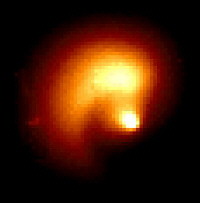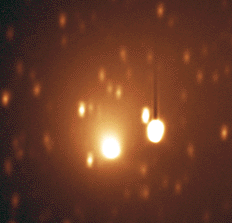Other Anomalous Pictures
The Strangest Picture of all was taken by the Hubble. Shortly after it's
release in October of 1995, there was suddenly a lack of good recent
Hubble pictures!
 After the release of this picture, JPL explained the two bright spots by saying one
of them was a "chunk" ejected from the comet. Yet the comet was far too far from
the sun for thermal or gravitational tides to account for this kind of action. More
than any other picture, this picture clearly shows a comet like object in orbit around
another body. It's a beautiful picture of a comet in orbit with it's tail maintaining a
near perfect circle as it orbits. This view is nearly head on to the comet. NASA also
tried to explain the "pinwheel" appearance of this picture by saying the comet was
spinning - like a lawn sprinkler and causing it's tail and the mystery "chunk" to
spiral off. Yet, all recent observations of the comet show it is not spinning. What
made it stop spinning? This too is a major question.
After the release of this picture, JPL explained the two bright spots by saying one
of them was a "chunk" ejected from the comet. Yet the comet was far too far from
the sun for thermal or gravitational tides to account for this kind of action. More
than any other picture, this picture clearly shows a comet like object in orbit around
another body. It's a beautiful picture of a comet in orbit with it's tail maintaining a
near perfect circle as it orbits. This view is nearly head on to the comet. NASA also
tried to explain the "pinwheel" appearance of this picture by saying the comet was
spinning - like a lawn sprinkler and causing it's tail and the mystery "chunk" to
spiral off. Yet, all recent observations of the comet show it is not spinning. What
made it stop spinning? This too is a major question.
This is a strange picture indeed. I don't think they meant for this one to get out. It was taken July 16,
1996 by the Tiede Observatory in the Canary Islands. The dark object at the center of the comet is an
optical device to prevent the bright nucleus from over exposing the comet and losing details of the
"jets." The diagonal orange and dark lines are the result of the telescope following the comet against a
background of stars (in highly enhanced and processed color.) But what the hell is that dark
circle in the 10 o'clock position from the comet that is not streaked like the stars and
apparently moving with the comet? Notice also that the "jet" from the comet heading toward
that thing appears to be influenced by the shape of the "thing." It looks as if the "jet"
expanded there to get around the "thing."
The Comet's Mysterious Eyes

Just days after the above picture was released, three
amateur astronomers in New Mexico took this
amazing picture. They used a 16 inch telescope with a
CCD imager to reveal something very strange
appeared "near" the comet nucleus for 10 to 20
minutes and then disappeared. I put the word near in
quotes because the actual distance if the object were
near the comet would be on the order of hundreds of
thousands of kilometers. This anomaly has not been
explained. It is not a background star as photos taken
at nearly the same time reveal no star there. It is also
not a CCD hot spot as those are most often just one
single pixel that is bad. This anomaly spans a number
of pixels and its brightness diminishes as the distance
from the hottest pixel increases. Ironicly, this picture
was displayed by a group of astronomers who had
nothing but ridicule for my picture.
 And this is really interesting. It's a picture taken by a half meter telescope in Japan
(about 20 inches.) The picture was taken in April of 1996. The bright spot in the two
o'clock position from the comet was first described as an anomaly. The picture was
displayed that way for 6 months. Later, when the comet and the "companion" started
getting some attention thanks to Art Bell and the internet, the Japanese did some
backtracking. They called the vertical rod emanating from the "object" a flaw in the
CCD imager and said the "companion" was really a star. If the vertical dark spire is
really a CCD flaw, then why does it have edges that appear brighter then the nearby
comet coma? A flaw would simply produce a dark line - not "outlined" in a lighter
color. Also, the "object" appears to have two faint comet like jets in the 8 and 4
o'clock positions. This picture has since completely disappeared from the Japanese
web site it was displayed on for many months.
And this is really interesting. It's a picture taken by a half meter telescope in Japan
(about 20 inches.) The picture was taken in April of 1996. The bright spot in the two
o'clock position from the comet was first described as an anomaly. The picture was
displayed that way for 6 months. Later, when the comet and the "companion" started
getting some attention thanks to Art Bell and the internet, the Japanese did some
backtracking. They called the vertical rod emanating from the "object" a flaw in the
CCD imager and said the "companion" was really a star. If the vertical dark spire is
really a CCD flaw, then why does it have edges that appear brighter then the nearby
comet coma? A flaw would simply produce a dark line - not "outlined" in a lighter
color. Also, the "object" appears to have two faint comet like jets in the 8 and 4
o'clock positions. This picture has since completely disappeared from the Japanese
web site it was displayed on for many months.
And Check This Report From Some Skywatchers in
Arizona
On Saturday night, Dec. 7th, a small group of us from MUFON AZ went out to our desert skywatch location to look for
comet HB. We spotted first with binoculars a little after sunset. We had to wait for the sky to darken in the west. It was low in
the west, maybe 15 deg. above the horizon and just a little north of the Milky Way. We had three telesopes. Our best
telescope was the Celestron C-8. The consensus of opinion is that HB has a companion. Now Alan Hale said to go out and
look for ourselves. We did, but it still looks like there is a second bright object near HB! We switched to a 187X power
eyepiece to look at it one last time before it descended into western haze.
AS a footnote, we also enjoyed looking at the rings of Saturn, the ring nebula in Lyra - this is just south of the bright star
Vega, and the galaxy in Andromeda.
Sincerely,
Bill Hamilton
 After the release of this picture, JPL explained the two bright spots by saying one
of them was a "chunk" ejected from the comet. Yet the comet was far too far from
the sun for thermal or gravitational tides to account for this kind of action. More
than any other picture, this picture clearly shows a comet like object in orbit around
another body. It's a beautiful picture of a comet in orbit with it's tail maintaining a
near perfect circle as it orbits. This view is nearly head on to the comet. NASA also
tried to explain the "pinwheel" appearance of this picture by saying the comet was
spinning - like a lawn sprinkler and causing it's tail and the mystery "chunk" to
spiral off. Yet, all recent observations of the comet show it is not spinning. What
made it stop spinning? This too is a major question.
After the release of this picture, JPL explained the two bright spots by saying one
of them was a "chunk" ejected from the comet. Yet the comet was far too far from
the sun for thermal or gravitational tides to account for this kind of action. More
than any other picture, this picture clearly shows a comet like object in orbit around
another body. It's a beautiful picture of a comet in orbit with it's tail maintaining a
near perfect circle as it orbits. This view is nearly head on to the comet. NASA also
tried to explain the "pinwheel" appearance of this picture by saying the comet was
spinning - like a lawn sprinkler and causing it's tail and the mystery "chunk" to
spiral off. Yet, all recent observations of the comet show it is not spinning. What
made it stop spinning? This too is a major question.
 And this is really interesting. It's a picture taken by a half meter telescope in Japan
(about 20 inches.) The picture was taken in April of 1996. The bright spot in the two
o'clock position from the comet was first described as an anomaly. The picture was
displayed that way for 6 months. Later, when the comet and the "companion" started
getting some attention thanks to Art Bell and the internet, the Japanese did some
backtracking. They called the vertical rod emanating from the "object" a flaw in the
CCD imager and said the "companion" was really a star. If the vertical dark spire is
really a CCD flaw, then why does it have edges that appear brighter then the nearby
comet coma? A flaw would simply produce a dark line - not "outlined" in a lighter
color. Also, the "object" appears to have two faint comet like jets in the 8 and 4
o'clock positions. This picture has since completely disappeared from the Japanese
web site it was displayed on for many months.
And this is really interesting. It's a picture taken by a half meter telescope in Japan
(about 20 inches.) The picture was taken in April of 1996. The bright spot in the two
o'clock position from the comet was first described as an anomaly. The picture was
displayed that way for 6 months. Later, when the comet and the "companion" started
getting some attention thanks to Art Bell and the internet, the Japanese did some
backtracking. They called the vertical rod emanating from the "object" a flaw in the
CCD imager and said the "companion" was really a star. If the vertical dark spire is
really a CCD flaw, then why does it have edges that appear brighter then the nearby
comet coma? A flaw would simply produce a dark line - not "outlined" in a lighter
color. Also, the "object" appears to have two faint comet like jets in the 8 and 4
o'clock positions. This picture has since completely disappeared from the Japanese
web site it was displayed on for many months.